2025-07-24
In the rapidly evolving food packaging landscape, manufacturers and consumers alike are prioritizing packaging solutions that combine durability, convenience, and sustainability. Among these innovations, seal zipper self-supporting food packaging bags have become a option, offering balance of product protection, resealability, and attractive presentation. This packaging format is gaining momentum across various food sectors due to its ability to keep products fresh longer while delivering an engaging consumer experience.
What Are Seal Zipper Self-Supporting Food Packaging Bags?
Seal zipper self-supporting food packaging bags are flexible pouches designed with a gusseted or flat-bottom base that allows them to stand upright on retail shelves without additional support. These bags feature a resealable zipper closure, often combined with a reliable seal that ensures airtight freshness and tamper evidence upon first opening.
Constructed from multilayer laminated films, these bags provide barrier properties to protect food from moisture, oxygen, and external contaminants. The zipper mechanism adds user convenience by enabling repeated opening and secure reclosing, maintaining product integrity throughout usage.
Core Benefits of Seal Zipper Self-Supporting Bags
Extended Freshness and Shelf Life: The airtight seal combined with a resealable zipper effectively locks in freshness and prevents spoilage by limiting exposure to air and moisture.
Convenience and Usability: Consumers appreciate the ease of opening and reclosing bags without the need for clips or transferring contents to other containers.
Shelf Stability and Visual Appeal: The self-supporting design enhances shelf presence by enabling upright display, improving visibility, and optimizing retail space.
Durability and Protection: Multi-layer film constructions offer resistance to punctures, tears, and physical damage during handling and transportation.
Branding and Customization: High-quality printing options allow vibrant, full-color designs that help products stand out and convey brand messaging effectively.

Applications in the Food Industry
Seal zipper self-supporting food packaging bags are versatile and well-suited to a broad spectrum of food products, including:
Snacks: Nuts, chips, popcorn, and dried fruits maintain crispness and flavor with resealable packaging.
Pet Food and Treats: Flexible bags provide airtight storage to preserve aroma and texture.
Coffee and Tea: Ground coffee and loose-leaf teas benefit from barrier films that prevent aroma loss.
Baking Ingredients: Flour, sugar, and mixes can be securely stored and conveniently used multiple times.
Confectionery and Candy: Resealable bags keep sweets fresh and prevent sticky messes.
Market Drivers and Consumer Trends
Consumer lifestyles increasingly demand packaging that supports convenience and sustainability without compromising product quality. Seal zipper self-supporting bags meet these expectations by enabling easy resealing to reduce food waste and offering compact, lightweight packaging that reduces transportation emissions.
The surge in e-commerce and direct-to-consumer food sales has also highlighted the need for robust, user-friendly packaging that can withstand shipping stresses and provide an engaging unboxing experience.
Sustainability remains a key factor, with many consumers favoring brands that utilize recyclable materials and minimize plastic use. Packaging manufacturers are responding with innovations in eco-friendly film technologies compatible with zipper pouches.
Technological Advancements
Ongoing innovations are enhancing the performance and appeal of seal zipper self-supporting food packaging bags:
Improved Zipper Designs: Features like easy-open sliders, tamper-evident seals, and child-resistant closures expand functionality.
Advanced Barrier Films: Incorporation of materials such as EVOH and metallized layers bolster protection against oxygen and moisture.
Eco-Friendly Materials: Development of recyclable mono-material films and compostable laminates align packaging with environmental goals.
Digital Printing: High-resolution, full-color printing techniques enable vibrant, customized branding with quick turnaround times.
Challenges and Industry Considerations
While these bags offer numerous advantages, challenges remain, including:
Balancing Cost and Sustainability: High-performance films and zippers can increase packaging costs, requiring manufacturers to optimize for both functionality and affordability.
Recycling Infrastructure: Complex multi-layer structures and zipper components complicate recyclability, prompting ongoing research into more sustainable alternatives.
Supply Chain Integration: Coordinating between film producers, converters, and brand owners is essential to maintain quality and meet demand.